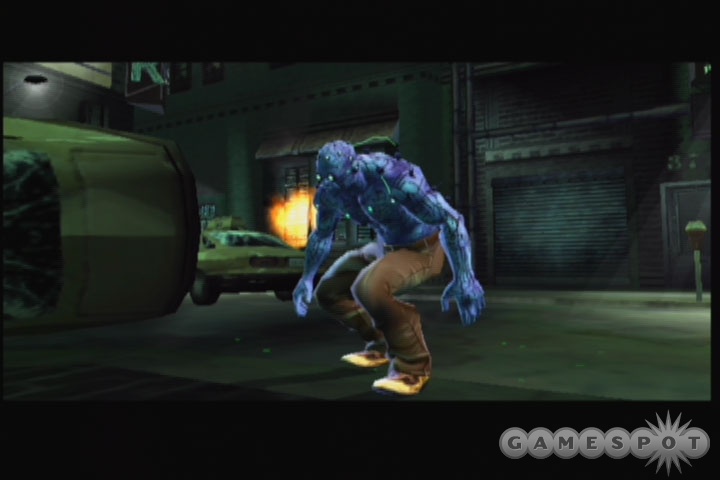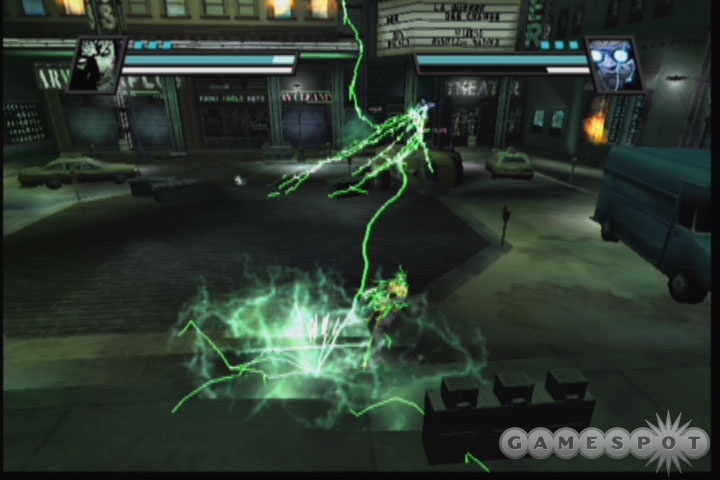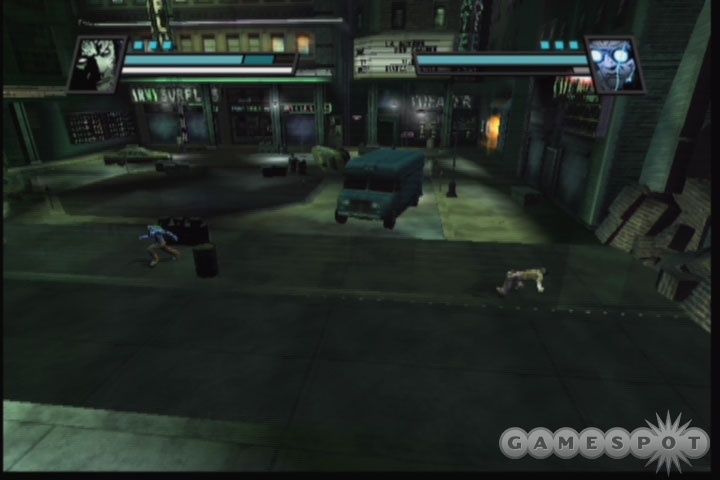On paper, Marvel Nemesis: Rise of the Imperfects, Electronic Arts' new fighting game, has all the ingredients usually found in a wild success. If you're looking for star power, Marvel Nemesis's solid selection of beloved comic book superheroes and brand-new metahumans fits the bill; Marvel's characters use all of their classic mutant attacks and techniques, and the rookie Imperfects hold their own, too. These guys can fly all over the screen, swing on webs, and throw cars at one another, just like in the comics. Plus, all of the action takes place in various fully destructible environments, and the whole package is supported by a pretty robust online infrastructure (except in the GameCube version of the game). Unfortunately, these parts, as promising as they are, do not form a particularly appealing whole. Marvel Nemesis has been engineered in such a way that you must slog through the game's weakest parts to gain access to its best features--and you'll have to wrestle with some serious balance and gameplay issues along the way.

Marvel Nemesis: Rise of the Imperfects's story makes about as much sense as you'd expect from a beat-'em-up built from decades of pulpy pop-culture clichés. Niles Van Roekel, a sinister bald fellow in a lab coat, has somehow precipitated an alien invasion of New York City. Over the course of several ugly in-engine cutscenes, you'll learn that Van Roekel himself is an alien, and he's hell-bent on developing an army of super powered goons to counterinvade another planet. Or something. In the course of his obsession, Van Roekel has failed repeatedly to generate the ultimate fighting machine--six times, to be exact. These six extremely dangerous assistants, known as the Imperfects, are Van Roekel's most powerful shock troops. In one-on-one combat, they're a match for the best superheroes (and villains!) Marvel can muster, from Spider-Man, Venom, and The Thing to Wolverine, Magneto, and Daredevil.
That's the best part of Marvel Nemesis by far: titanic battles between super powered adversaries. The problem is that the developer has buried these occasional clashes in an ocean of mediocre, homogenous, button-mashing gameplay. In order to unlock most of the game's content--which includes playable characters for use in the one-on-one mode or online combat, collectable cards, animated comic books, and several short videos--you have to get through the game's interminable single-player scenario. This consists of dozens and dozens of short levels that take place in just a handful of fighting environments, which you'll return to again...and again...and again. You may start at a different point in the arena, or have a different objective to satisfy, like blowing up power generators or throwing a certain number of enemies into a pit, but it feels like the same thing in every single case.
The game tries to dress this up as a kind of story-driven adventure by giving you a choice of up to four different characters' paths every time you beat a level. For instance, you might play through The Thing's story for a couple levels, until you best one of the other characters in a boss fight. Then, you'll have exhausted that story path for a while and you'll have to switch to another character, like Storm. Each character has both a good and evil manifestation, depending on whether they've been subjected to Van Roekel's alien mind-control technology. This is how the game rationalizes all of the bizarre match-ups it throws at you.

Sadly, there's no such excuse for the seemingly endless army of faceless alien mooks, of which there are only a few basic types, that you have to defeat on the way to a boss fight. The assorted little guys try to slash at you with blades, shoot you with blasters, or grab on to you and blow up; you can typically kill them with a single flurry on the attack button. Bigger guys can actually deflect your basic blows, counterattack, and teleport, as well as throw heavy objects at you. They take about three basic combinations to kill. Finally, there are the flying enemies, which are definitely the scourge of the single-player game. These things are very, very difficult to hit, and they can do an absurd amount of damage with their blasters.
The single-player levels are mind-numbingly simple at first, but they ramp up in difficulty quickly, although there's no consistent challenge gradient. Simply put, Marvel Nemesis's gameplay system was pretty clearly designed for one-on-one fights, and it doesn't function very well when you're confronted by multiple enemies. For example, there's no lock-on system for directing your attacks--you simply have to try to line up your character with the enemy and then launch your assault. Therefore, it can be difficult to defend against attacks from multiple directions. The camera mechanic doesn't make fighting multiple enemies any easier, because it'll zoom in and out at odd points, and many enemies will launch attacks from offscreen. The game won't tell you when this is happening, or from what direction, so you may be blindsided by a thrown car, right in the middle of punching another enemy out. The right analog stick allows you to free-look, but it's impossible to do that effectively in the middle of a brawl; mostly, you'll just have to try to keep the bad guys in front of you.
Another serious problem has to do with the game's overuse of environmental obstacles and weapons. It seems like most of the levels are saturated with things that can be picked up and thrown, and many of these things are also explosive. Whether you get beaned by a small piece of equipment or are subjected to an exploding oil drum, you'll take far more damage than you would from other types of attacks...and it's far too easy to wander into a field of explosive objects in the middle of a fistfight. Yes, it's possible to catch thrown objects and toss them back, but the fact that there's no way to refill your life gauge (except in very rare circumstances) leaves very little margin for error. The environmental combat is a neat idea, and it's well-executed in some respects, but the game leans on it too heavily.
Indeed, the single-player game's many imbalances and loose ends make it feel like a hastily sketched-out afterthought, rather than the vital component it supposedly is. For instance, if your character has a projectile attack, it may autotarget the enemy you're aiming at--or a stone column right next to it. On the other hand, if you don't have a projectile attack, it's literally next to impossible to line up an attack on the flying drones, which will pick you apart from the air; it's not unusual to be pinned in a corner and simply dispatched in a few seconds, with no chance for recourse. Finally, parts of the enemy artificial intelligence simply feel broken. If you stand at the edge of a gap, grunts on the other side will simply fall right in and die. Even the bosses don't display much in the way of street smarts; we occasionally witnessed them launch blistering attacks while facing in exactly the wrong direction. This heap of small annoyances adds up to a frustrating experience overall, no matter how skilled you may be.

All this is a shame, because the game's controls actually make a lot of sense for more casual players. As mentioned above, there's a basic attack button that'll create combos with repeated tapping, a jump, a block/dodge, and a throw. The left shoulder button controls movement powers, like Storm's flight and The Wink's teleportation, while the right shoulder button applies super powers to whatever you're doing at the time. For instance, holding down the right trigger while attacking will trigger an extrapowerful combo, while performing a power throw can initiate a brutal finishing move in one-on-one combat (sadly, you cannot skip these animations--and some of them are on the long side). Using super powers depletes your power meter, but it also fills up the rage meter, which will grant you temporarily unlimited use of super powers when full. Otherwise, the power meter recharges slowly on its own, and you can accelerate the charge by holding down the right shoulder button while stationary.
With some practice, this system can prove to be both elegant and entertaining, provided that you're fighting a duel. While playing as Spider-Man, it's a great feeling to be able stick to a wall, snag a nearby statue with some webbing, and send it hurtling towards an enemy. Each character has at least one mind-blowing maneuver like that, such as Venom's totally insane corkscrew attacks or Paragon's bomb trails. It's a little too easy to execute a finishing move, though. All you need to do is perform a massive attack on your opponent, causing them to momentarily enter a "danger" state, and then pull off a power throw while relatively close to them; you need not deplete their life meter completely, and there's no counter against it.
The PS2 and Xbox versions of the game feature a fairly robust online mode that's easily the game's most enjoyable feature. You can jump into a quick match with another player, or set various parameters for a more controlled experience. Obviously, other players won't exhibit the same behavioral quirks as some of the CPU-controlled opponents, so the fighting feels somewhat more natural, and there's no apparent lag at any point. The game keeps track of your success rate, too, and offers up very comprehensive stat tracking and leaderboards for comparative purposes. Although it still has access to offline duels against a CPU or human opponent, the GameCube version of the game lacks online multiplayer entirely, and this is a sore loss indeed.

Marvel Nemesis: Rise of the Imperfects has a good presentation, but it doesn't clear the bar by a very wide margin. This is a very character-focused game, so it makes sense that much of its graphical flashiness resides in the character animation, which is absolutely top-shelf. The developer seems to have taken great pains to make the characters move and fight the same way they do in the comic books, and the effort has paid off. The faster characters, like Spider-Man and Fault Zone, flit about with a fluid grace, while big guys like The Thing really look massive and can shatter the pavement with their jumps. All of the attacks, movements, and powers have a highly authentic feel to them, which is sure to please Marvel fans. At its best, this game really does look like you're playing a through a comic book.
The environments where the characters do their fighting, however, aren't nearly as fun to look at. Most of them are actually sort of bland. Most of the walls are decked out in dull, lifeless textures, and the light and shadow effects are mediocre for a console game coming out in late 2005. It seems as though the developer was going for a flat-shaded comic book look, but wasn't quite able to pull it off convincingly. Furthermore, the destructible elements in the arenas don't fall apart or blow up with a convincing degree of violence--exploding cars will produce a shock wave, for instance, but they don't send out a shower of debris, and the husk is just an ugly black polygon. The looks the best in the GameCube and Xbox versions of the game, which is able to render the lighting effects and textures with a little more subtlety; the PS2 version is pretty comparable, though. Happily, the frame rate holds steady in all three versions, even when there are many moving objects onscreen.
Marvel Nemesis's sound is pretty average for a game of its type. The sound effects are good enough to augment the onscreen violence--especially when you start zapping baddies with lighting bolts or throwing fireballs--but they're certainly not going to knock anyone's socks off. Overall, they're a pretty quotidian collection of beat-'em-up thumps, bashes, and breaking glass. The game's music is also on the forgettable side; it's standard-issue superhero stuff, with lots tense-sounding synth orchestras and keyboards. It blends into the background nicely, which is probably exactly what the developer intended. The voice acting sells the characters, each of whom get silly opening and closing lines, as well as some occasional dialog during the cutscenes. It's not award-winning work, but it's not bad, either.
Marvel Nemesis: Rise of the Imperfects could have been a decent beat-'em-up game that provided some great fan service, if its poor single-player scenario hadn't unhinged the entire process. This game has tons of content, great characters, and simple controls, suggesting that it was designed with more casual players and/or Marvel fans to pick up and immediately enjoy--but the ragged gameplay mechanics and balance issues that infest the one-player game will likely frustrate this very same audience to no end. If you're a patient player that's into the subject material, you'll probably get some benefit out of Marvel Nemesis, thanks to the wealth of comic book goodies and the solid online fighting. All others should approach this game with caution, because there are certainly better beat-'em-up fighters out there.